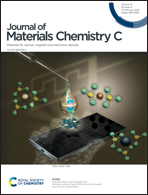(DSF)n-graphene: a carbon semimetal with double stacking faults†
Abstract
The synthesis of graphene-like structure [Fan et al., Science 372 (2021) 8527] with periodically embedded one-dimensional grain boundaries [Liu et al., Nat. Commun. 8 (2017)14924] is a strong incentive for exploration of carbon allotropes. In this work, a series of stable carbon allotropes with Dirac cones, (DSF)n-graphene, consisting of graphene nanoribbons and one-dimensional grain boundaries are proposed. The grain boundary composed of tetragonal and octagonal rings is constructed by a double stacking fault (DSF), where n refers to the width of the nanoribbon between the two grain boundaries. Interestingly, the Dirac cone of (DSF)n-graphene is mainly contributed by the atoms of grain boundaries, thus forming a one-dimensional conductive channel. Specifically, with the increase of n, the position of the Dirac points changes periodically on the two high symmetry lines, and the DSF ensures the robustness of the Dirac cones. Both (DSF)3-graphene and (DSF)4-graphene, as two prototypes, have Fermi velocities comparable to graphene, although the Dirac cones of the two are distributed on different high symmetry lines. Importantly, the calculation of surface states proves that (DSF)3-graphene and DSF4-graphene have nontrivial topological features. Furthermore, the massless Dirac fermions in the one-dimensional conductive channel bring many promising applications for future electronic devices.



 Please wait while we load your content...
Please wait while we load your content...